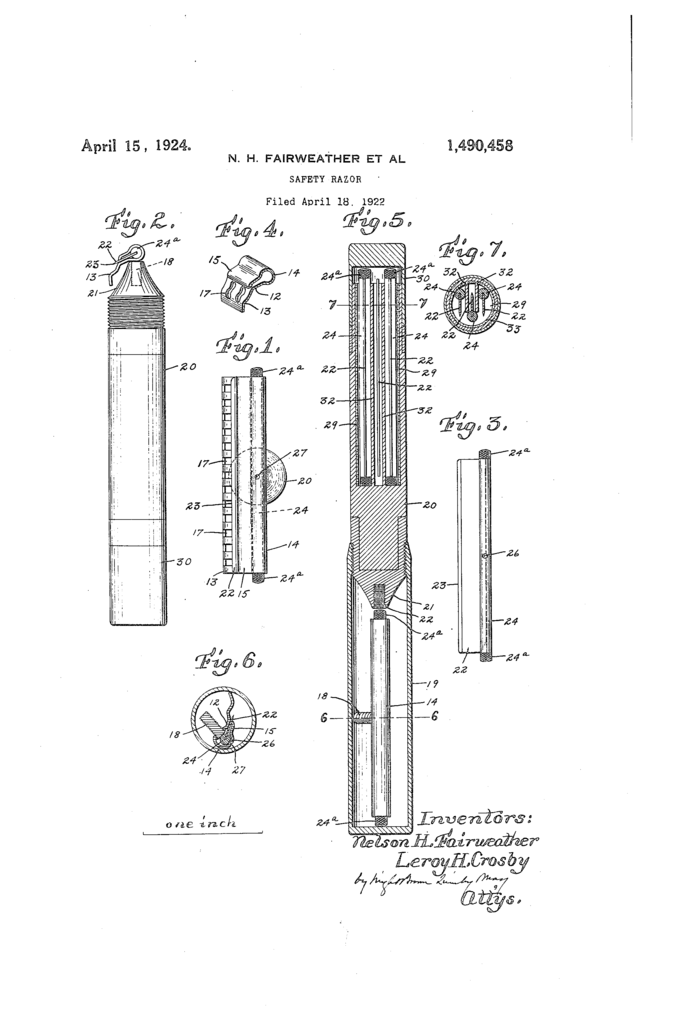During my prodding into the weird and wonderful world of pen-shaped razors,1 I found a rather neat single edge razor. Nelson H Fairweather and Leroy H Crosby filed for the patent in 1922, and it was granted two years later. What originally drew my eye was what they choose to store in the handle.
Not a brush, nor soap, nor a styptic pencil.2 Not even a pair of tweezers.3
No, Nelson and Leroy suggested putting something boring and utilitarian in the handle. Spare blades. Three of them. And since they had to fit inside the handle, they are rather narrow blades.
To quote the patent text:
This invention is embodied in a safety razor of improved construction, adapted to be carried in a garment pocket, when not in use, and to be readily converted into an operative razor, the construction being such that the blade-holding head may be stored in one end portion of the structure, and a plurality of blades in the opposite end portion.
From US patent 1,490,458
As can be seen from the patent drawing, it was a rather neat single edge razor. The one piece head could be unscrewed from the handle. When unscrewed, the head would be stored in the cap.
The head, which was made of a springy material, was shaped so the blade could be pushed in from one side. The comb was formed by a downturned lip with cut-outs. To quote again:
The head or blade-holding portion of our improved razor is preferably made from a blank of resilient sheet metal, bent to form a blade-rest portion 12, a guard portion 13, extending downward and forward from the rest portion, a resilient partially tubular neck 14, forming a socket portion, adapted to receive the reinforcing back of the blade hereinafter described, and a clamping lip 15, which is normally held by the resilience of the neck in yielding contact with the rest portion 12.
From US patent 1,490,458
…
The guard portion is apertured for the passage of lather through it, preferably by slots 17, as shown by Figure 4, so that the guard portion has a continuous lower edge. The clamping lip is immediately over the ridge formed by the junction of the rest portion 12, and the guard portion 13.
The shape of the blade is also interesting. It wasn’t flat, like a Christy blade. Instead it had a spine, more like the Ever-Ready and GEM blades. Unlike those though, the spine was cylindrical. And it was the cylindrical spine which registered the blade – determined the blade position. To once again quote:
The blade 22 is flat-sided, and has a single cutting edge 23, its opposite or back edge being inserted in a slot in a cylindrical reinforcing back 24. Said slot is formed to receive the back edge and minor portions of the sides of the blade, so that the major portions of the blade sides are exposed. The blade is therefore adapted to occupy a space of minimum width between the rest 12 and the clamping lip or ear 15. The back and blade are formed to be engaged with the head by sliding the back into the socket portion 14, and the blade between the rest portion 12 and the clamping ear 15. This operation expands the socket and raises the ear, which exerts a clamping pressure on the blade. Displacement of the blade in all directions, excepting endwise, is prevented by the head.
From US patent 1,490,458
In short, slide the blade in sideways.4 The clamping action of the head will keep it from moving. A benefit of the narrow blade – beyond requiring less material – was that three spares could fit in the handle.

All in all a very neat single edge razor, and I would I would like to have owned. It likely failed because the market was already getting saturated with safety razors. The patent is expired, but I believe that introducing a new blade on the marked would be more difficult today than it would have been a hundred years ago.
As usual, the full text of the patent can be read at Google Patents.
Footnotes
- See, among others, the pen style shavette, Bowlin’s shaving kit, the All-Flex pocket razor, the combination writing instrument and shaver’s kit, and Gotto’s hygiene implement.
- As Martin C Dellinger and Marcellin Eyraud Jr got patents for.
- An idea John R Gilda mentioned in his 1909 patent.
- It could be argued this foreshadowed injector razors. On the other hand, Nelson & Leroy’s razor did not need a magazine or key.
